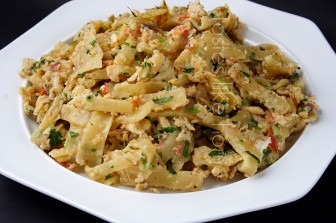Hi Everyone,
I receive a lot of emails from people crying out in frustration wondering why their once soft, fluffy, hot roti has gone dry or hard by the afternoon. They ask: “Where did I go wrong? I followed the recipe exactly!” I hold their hands (virtually), lead them to a chair, and set about calming their frustrations.
“You’ve done nothing wrong,” I say. “Let me explain some things about roti so that the next time, you’re not discouraged.”
Roti is meant to be eaten very soon after it is made; it is best when it is hot. It is soft, pliable and fluffy and full of flavour and that is whether we are talking about a parartha roti (aka plain roti, oil roti), dhal puri, sada roti, dosti roti, etc. To keep the roti warm as they are being made, we line a basket, bowl or some container with cloth kitchen towels and wrap the roti to keep them warm until we are ready to sit down to eat, usually as soon as the last roti is finished cooking. Ideally, roti is not meant to be cooked early in the morning only to be eaten in the evening for dinner. If roti is cooked in the morning then it should ideally be eaten in the morning or at the latest by lunchtime. If you are planning to have roti for dinner, then make the roti closer to dinnertime. Now, this is not a hard and fast rule but one by which we should be guided if we want to eat and enjoy roti at its peak of taste and freshness.

I know that some of you may be shaking your heads and saying you do not want to be cooking when your guests arrive, or how I can have my guests eating by themselves without the host at the table; easy, you have guests that understand the food and appreciate the process by which certain foods are presented and eaten. For example, in many Chinese households, depending on the kind of meal being served, the hosts often do not sit with you at the table until they are done cooking and that is because the dishes they are making must be cooked, and be presented to be eaten right away, particularly dishes involving wok-style cooking. In this kind of setting, the cooks/hosts want to ensure that the essence of wok-style cooking (wok hei) is sumptuously enjoyed by their diners – for flavour, taste, texture and temperature. And so it is with roti. You want to serve it hot and at its optimum flavour and texture.
Reheating
Now, if like me, you don’t make roti often but like to have it around just in case one day you feel like having roti, then you can certainly make a set and freeze or refrigerate it.
Let’s deal first with roti that you might have cooked today and have left over that you are planning to use the next day. Start by wrapping the roti individually in greaseproof paper and add the lot to a zip plastic bag and refrigerate. The next day when you are ready to reheat the roti, here’s what you do.
Place one the greaseproof-wrapped roti directly on the plate in the microwave and cover it with a microwave cover, do not skip this. Punch in 30-35 seconds on your microwave and let the roti reheat. That is all the time you need. Now, I strongly advise you to only reheat the roti when you are about to eat it. In other words, do not reheat the roti with plans to eat it 15-20 minutes later. If it is that you have reheated the roti but find that you are not quite ready to eat it for another few minutes, then leave it covered in the microwave to keep warm until you are ready. Only unwrap the roti when you sit down to eat it, this way, it remains fresh and warm.
There is another way in which you can reheat the roti, and this works great with bread too. Remove the greaseproof wrapping from the roti. Take two pieces of kitchen paper towel, wet the towels and squeeze out the excess water, now wrap the roti in the damp towel, place it on the microwave plate, cover it with a microwave cover and heat it for 25-30 seconds only. Again, do this only when you are about to sit down to eat the roti.

If you’ve made roti that you want to store for a longer period of time, then wrap each roti, individually, first in greaseproof paper and then in aluminium foil. Add the lot to a zip plastic bag and place in the freezer. When you are ready to use and reheat. Remove what you need from the freezer and let it come up to room temperature, about 15-20 minutes. Remove the foil wrapper only and place the greaseproof-wrapped roti into the microwave, cover with a microwave cover and reheat for 30-35 seconds. Alternately, you can remove all the wrappers and wrap in damp kitchen paper towels and reheat for 30 seconds. Again, only reheat when you are about to sit down to your meal.
Kottu
You can take your left-over roti to new heights by making a very popular Sri Lankan dish caked Kottu. In its simple form, Kottu is roti that is cooked with aromatics such as onions, garlic, ginger, and cilantro, and sometimes spices. It can be made plain or with eggs, cooked meat or left over curries. Everything is tossed together in a pan and served hot and fresh. Don’t be fooled by the fact that this dish is made with leftovers, it is very filling and can be served for breakfast, lunch or dinner.
Here’s a recipe for an Egg Kotthu I made.
Egg Kotthu
INGREDIENTS
2 tablespoons oil
½ cup diced onions
½ cup diced tomatoes
2 cloves garlic, minced
¼ cup chopped cilantro
Minced hot pepper, to taste
3 eggs, beaten (but not frothy)
3 paratha roti, cut into 1 ½ -inch strips
Salt to taste
¼ cup water
2 green onions sliced thinly (white and green parts)
DIRECTIONS
1. Heat oil in pan.
2. Add onions and sauté until translucent.
3. Add tomatoes, garlic, cilantro and pepper and cook for 1 minute
4. Add eggs and scramble lightly. Before eggs are fully cooked, add roti and toss to mix, season with salt to taste.
5. Add water and reduce heat to low and cook covered for 5 minutes or until roti becomes soft and heated through. The mixture should be dry.
6. Toss in green onions and mix. Cook for 1 minute, remove from heat and serve.
NOTE
For Kotthu made with left over curry and roti – cut the meat into small, bite size pieces. Heat oil and sauté the meat alone, add the chopped roti, toss to mix, then add the gravy from the curry and a little water if necessary. Cook on low heat until everything is heated through and there is no liquid. Taste for salt and adjust if necessary. Serve immediately. Garnish with cilantro if you have.





